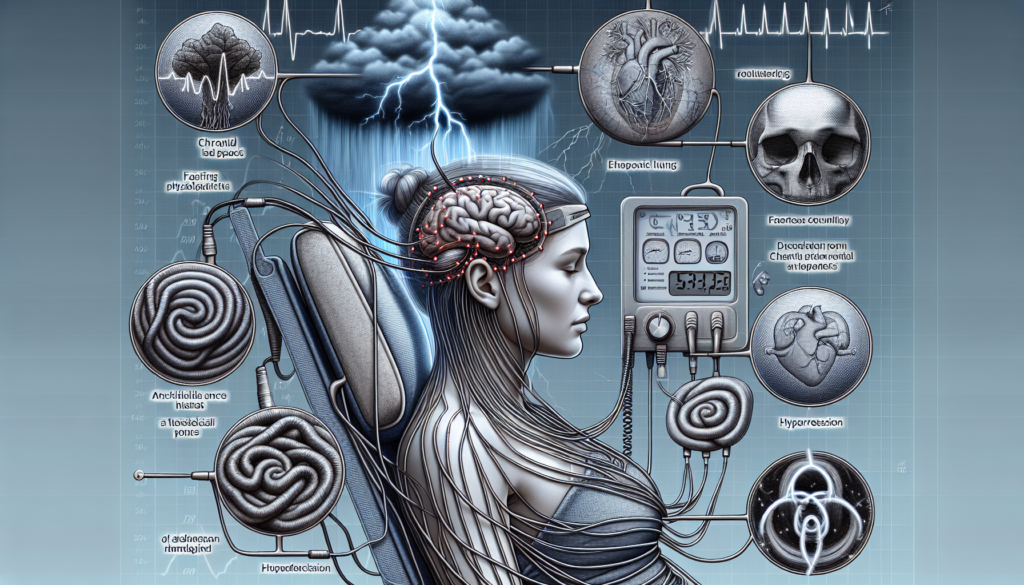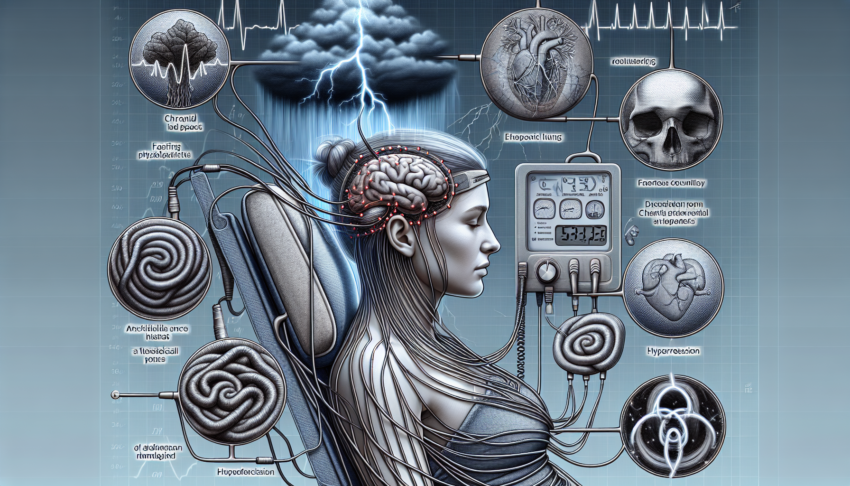Have you ever wondered how biofeedback plays a crucial role in alternative medicine? Biofeedback, a technique that allows individuals to gain control over their bodily functions, is becoming increasingly popular in the realm of alternative medicine. By providing patients with real-time information about their physiological processes, biofeedback empowers them to make conscious changes to improve their health and well-being. This article explores the benefits of biofeedback in alternative medicine practices and how it can be used as a powerful tool for self-healing and personal growth.
Understanding Biofeedback
Biofeedback is a therapy technique that allows individuals to learn how to consciously control their physiological processes, such as heart rate, blood pressure, and muscle tension. By providing real-time feedback through monitoring devices and sensors, biofeedback helps individuals become more aware of their internal bodily functions that are usually beyond conscious control. This knowledge can then be used to gain control over these bodily functions and promote overall health and well-being.
Definition of Biofeedback
Biofeedback involves the use of electronic monitoring devices to measure and display physiological information that is not typically accessible to individuals. Through sensors placed on the body, biofeedback instruments detect physiological changes in functions such as heart rate, skin temperature, muscle activity, and breathing patterns. This information is then translated into visual or auditory feedback, enabling individuals to understand and alter their physiological responses.
Historical Background
The concept of biofeedback dates back to ancient times, where practices such as meditation and controlled breathing were used to achieve physiological and mental harmony. In the 19th century, research on autonomic nervous system responses laid the groundwork for modern biofeedback techniques. However, it was not until the mid-20th century that biofeedback gained recognition as a clinical treatment tool. Over the years, advancements in technology and research have contributed to the development of various biofeedback techniques and their integration into alternative medicine practices.
Key Principles of Biofeedback
Biofeedback is based on several key principles. The first principle is the belief in the mind-body connection, which holds that mental processes can have a profound impact on bodily functions. Biofeedback also operates on the premise that individuals have the ability to influence and regulate their physiological responses consciously. This principle is supported by the idea that explicit information about bodily processes facilitates control over them. Finally, biofeedback emphasizes the importance of self-regulation and self-awareness, encouraging individuals to take an active role in their own health and well-being.
Alternative Medicine Practices
Alternative medicine refers to a diverse set of healthcare practices and therapies that are not typically considered part of conventional medical systems. These practices often focus on a more holistic approach to health, emphasizing the interplay between the mind, body, and spirit. Alternative medicine seeks to complement or replace conventional medical treatments with natural, non-invasive, and often self-administered techniques.

Definition of Alternative Medicine
Alternative medicine encompasses a wide range of practices, including acupuncture, naturopathy, homeopathy, traditional Chinese medicine, herbal medicine, and energy healing. These practices are rooted in different cultural traditions, philosophies, and belief systems. Alternative medicine typically takes a personalized approach, addressing the unique needs and circumstances of each individual.
Types of Alternative Medicine Practices
Alternative medicine practices can be categorized into various types, each addressing different aspects of health and well-being. Some common types of alternative medicine include:
- Traditional Chinese medicine: Based on the principles of balance and harmony, this practice involves acupuncture, herbal medicine, and lifestyle modifications.
- Ayurveda: Originating from India, Ayurveda focuses on the balance of three vital energies or doshas and utilizes techniques such as herbal remedies, dietary changes, and meditation.
- Homeopathy: This practice employs highly diluted substances to stimulate the body’s healing abilities and restore balance.
- Naturopathy: A holistic approach that emphasizes the body’s self-healing capacity through natural interventions like nutrition, herbal medicine, hydrotherapy, and lifestyle modifications.
Benefits and Limitations of Alternative Medicine Practices
Alternative medicine offers several potential benefits, such as individualized treatment plans, minimal side effects, and a focus on prevention rather than just symptom management. Many alternative medicine practices also encourage active patient participation, empowering individuals to take control of their own health. However, it is important to recognize that alternative medicine may not always be effective for all conditions, and its use should be guided by evidence-based research and in conjunction with conventional medical treatments when necessary.
Biofeedback Techniques in Alternative Medicine
The integration of biofeedback into alternative medicine practices has been a significant development in recent years. Biofeedback techniques complement the principles of alternative medicine by providing individuals with real-time information about their physiological responses. This knowledge allows individuals to gain control over their bodily functions and enhance self-regulation, further supporting their overall wellness.
Incorporating Biofeedback into Alternative Medicine
Alternative medicine practices can benefit from incorporating biofeedback by integrating the use of monitoring devices and sensors. By providing individuals with immediate feedback about their physiological responses, biofeedback enhances their awareness of their bodily functions. This awareness helps individuals identify patterns, triggers, and imbalances in their physiological processes, enabling them to make informed decisions and take necessary steps to restore balance and achieve optimal health.

Different Biofeedback Techniques Used in Alternative Medicine
Various biofeedback techniques are used in alternative medicine to target specific physiological functions. Some common techniques include:
- Electromyography (EMG): Measures muscle activity and helps individuals learn to relax tense muscles, reducing pain and promoting relaxation.
- Thermal biofeedback: Monitors skin temperature and assists in stress management and relaxation techniques.
- Heart rate variability (HRV) biofeedback: Assists individuals in achieving balanced heart rate patterns, promoting cardiovascular health and reducing anxiety and stress.
- Respiration biofeedback: Provides feedback on breathing patterns, helping individuals regulate their breathing and promote relaxation.
- Neurofeedback (EEG biofeedback): Monitors brainwave activity and assists in improving attention, reducing anxiety, and managing certain neurological conditions.
The Role of Biofeedback in Promoting Self-Regulation
Biofeedback plays a crucial role in promoting self-regulation, a key aspect of alternative medicine practices. By providing individuals with explicit information about their physiological responses, biofeedback enables them to recognize patterns and make conscious adjustments to achieve desired states. This self-regulation empowers individuals to take an active role in managing their physical, mental, and emotional well-being, leading to enhanced overall health and quality of life.
Benefits of Biofeedback in Alternative Medicine
The incorporation of biofeedback in alternative medicine practices offers several benefits, supporting the overall health and well-being of individuals.
Improving Mind-Body Connection
Biofeedback enhances the mind-body connection by providing real-time feedback on physiological processes that are influenced by mental and emotional states. By becoming aware of this connection, individuals can develop a deeper understanding of the impact of their thoughts, emotions, and behaviors on their physical well-being. This awareness allows them to make conscious choices to promote balance and harmony.
Managing and Reducing Stress
Stress is a pervasive issue in modern life and can have a profound impact on overall health. Biofeedback techniques, such as heart rate variability and thermal biofeedback, offer effective tools for managing and reducing stress. By providing individuals with immediate feedback on their stress responses, biofeedback enables them to implement relaxation techniques, regulate their physiological responses, and improve their resilience to stressors.

Enhancing Overall Well-Being and Quality of Life
By promoting self-regulation and providing individuals with tools to manage their physical, mental, and emotional well-being, biofeedback contributes to enhanced overall well-being and improved quality of life. The ability to consciously regulate physiological responses empowers individuals to take charge of their health, leading to increased self-confidence, reduced dependency on medications, and a greater sense of control over their well-being.
Conditions Treated Using Biofeedback in Alternative Medicine
Biofeedback has been found to be effective in managing and treating various conditions when used in conjunction with alternative medicine practices.
Chronic Pain Management
Chronic pain, such as fibromyalgia, migraines, and back pain, can significantly impact an individual’s quality of life. Biofeedback techniques, particularly electromyography (EMG) and thermal biofeedback, have shown promising results in reducing pain intensity and improving pain management skills. By learning to control muscle tension and promoting relaxation, individuals can experience a reduction in pain and an improved ability to cope with chronic pain.
Anxiety and Stress-Related Disorders
Biofeedback techniques have proven to be beneficial in managing anxiety and stress-related disorders such as generalized anxiety disorder, panic disorder, and post-traumatic stress disorder (PTSD). Techniques like heart rate variability (HRV) biofeedback and respiration biofeedback help individuals develop skills to regulate their physiological responses, leading to reduced anxiety symptoms, improved emotional well-being, and enhanced resilience to stress.
Headaches and Migraines
Biofeedback has been widely recognized as a successful treatment option for individuals experiencing frequent headaches and migraines. By providing feedback on muscle tension and other physiological responses, biofeedback helps individuals identify triggers and learn relaxation techniques that can alleviate symptoms and reduce the frequency and intensity of headaches and migraines.

Digestive Disorders
Gastrointestinal disorders, such as irritable bowel syndrome (IBS), can be challenging to manage. Biofeedback techniques, such as abdominal breathing and EMG biofeedback, have shown promise in reducing symptoms associated with digestive disorders. By promoting relaxation and modifying physiological responses, biofeedback can help individuals regulate their digestive processes and improve overall gut health.
Musculoskeletal Conditions
Biofeedback techniques have demonstrated effectiveness in managing musculoskeletal conditions, including tension headaches, temporomandibular joint disorders, and chronic back pain. By providing individuals with real-time information about muscle tension and facilitating relaxation and postural adjustments, biofeedback aids in reducing pain, improving mobility, and enhancing physical well-being.
Biofeedback and Mindfulness Practices
Biofeedback and mindfulness practices are two complementary approaches that can work synergistically to enhance health and well-being.
Exploring the Intersection of Biofeedback and Mindfulness
Both biofeedback and mindfulness practices focus on increasing self-awareness and developing skills for self-regulation. Mindfulness involves training individuals to consciously direct attention to the present moment without judgment, while biofeedback provides real-time feedback on physiological processes. The combination of these practices allows individuals to cultivate deep awareness of both their internal experiences and their physiological responses.
Benefits of Combining Biofeedback and Mindfulness
The combination of biofeedback and mindfulness practices amplifies the benefits of each approach. By combining biofeedback’s real-time feedback on physiological responses with mindfulness’s nonjudgmental awareness, individuals can deepen their self-regulation skills and gain a better understanding of the mind-body connection. This combination enhances stress management, emotional regulation, and overall well-being.

Techniques for Incorporating Both Practices
To incorporate both biofeedback and mindfulness practices, individuals can start by using biofeedback techniques to develop awareness of their physiological responses. Once familiar with these responses, individuals can then apply mindfulness techniques to observe and accept these responses without judgment. This integration facilitates the development of self-regulation skills and supports individuals in achieving optimal health and well-being.
Research and Evidence Supporting Biofeedback in Alternative Medicine
Biofeedback techniques have been widely studied, and numerous scientific studies, meta-analyses, and patient testimonials support their effectiveness in alternative medicine practices.
Scientific Studies on Biofeedback’s Effectiveness
Numerous scientific studies have demonstrated the effectiveness of biofeedback techniques in various health conditions. Research has shown that biofeedback can significantly reduce pain, decrease anxiety and depression symptoms, enhance cardiac and respiratory function, and improve overall quality of life. The versatility of biofeedback techniques and their ability to address multiple physiological processes make them a valuable tool in alternative medicine.
Meta-Analyses and Systematic Reviews
Meta-analyses and systematic reviews provide a comprehensive overview of multiple research studies. These analyses consistently demonstrate the efficacy of biofeedback techniques in various conditions, including chronic pain, stress-related disorders, migraines, and gastrointestinal disorders. The robust evidence from these reviews further strengthens the case for integrating biofeedback into alternative medicine practices.
Patient Testimonials and Anecdotal Evidence
Patient testimonials and anecdotal evidence also serve as valuable sources of information regarding the effectiveness of biofeedback. Many individuals have reported significant improvements in their symptoms and overall well-being after incorporating biofeedback into their alternative medicine treatments. Such testimonials not only provide anecdotal support but also highlight the personal experiences and subjective perceptions of individuals benefiting from biofeedback.
Biofeedback Training and Certification
Becoming a biofeedback practitioner requires specific training and certification to ensure safe and effective practice.
Requirements for Becoming a Biofeedback Practitioner
The specific requirements for becoming a biofeedback practitioner may vary depending on the country and jurisdiction. In general, individuals interested in pursuing a career in biofeedback must possess a background in healthcare, psychology, or a related field. They may need to complete additional training programs, gain clinical experience, and meet recognized certification criteria to practice biofeedback professionally.
Training Programs and Courses
Numerous accredited institutions offer specialized training programs and courses in biofeedback. These programs typically cover the theoretical foundations of biofeedback, practical techniques, ethical guidelines, and hands-on experience with equipment and software. Courses can often be completed online or in-person, allowing individuals to tailor their education to their specific needs and goals.
Certification and Continuing Education
Certification serves as a credential that signifies a practitioner’s competence in biofeedback. Several organizations offer certification programs that require applicants to demonstrate their knowledge and proficiency through written exams, practical assessments, and clinical case studies. Once certified, practitioners are encouraged to engage in continuing education to stay current with the latest developments and advancements in the field.
Integration of Biofeedback in Conventional Medicine
Biofeedback has gained recognition in mainstream healthcare for its potential to enhance conventional medical treatments and improve patient outcomes.
Role of Biofeedback in Mainstream Healthcare
Biofeedback has been embraced as a complementary therapy in conventional medicine. It is often used in conjunction with conventional medical treatments to address a wide range of conditions, including chronic pain, cardiovascular diseases, behavioral disorders, and rehabilitation. The non-invasive nature of biofeedback, combined with its ability to empower individuals to actively participate in their healing process, makes it a valuable asset to mainstream healthcare.
Collaboration between Alternative and Conventional Medicine
The integration of biofeedback in both alternative and conventional medicine has created opportunities for collaboration between these two approaches. While alternative medicine emphasizes holistic care and self-regulation, conventional medicine provides expertise in diagnostics and disease management. Collaborative efforts between practitioners from these fields can lead to comprehensive, patient-centered care that combines the benefits of both approaches.
Potential for Future Integrations
The potential for further integration of biofeedback and alternative medicine into conventional healthcare is promising. As research continues to support the effectiveness of these practices, healthcare providers are increasingly recognizing and embracing their value. The future holds potential for the incorporation of biofeedback into various medical specialties and the development of interdisciplinary approaches that prioritize personalized, patient-centered care.
Conclusion
Biofeedback offers a valuable contribution to alternative medicine practices by providing individuals with the tools to understand and control their physiological processes consciously. Through real-time feedback on internal bodily functions, biofeedback empowers individuals to enhance their self-regulation skills and promote overall well-being. Its effectiveness in managing a wide range of conditions, such as chronic pain, anxiety disorders, and digestive disorders, has been supported by scientific research and patient testimonials. As biofeedback continues to be integrated into alternative medicine and mainstream healthcare, its potential for improving health outcomes and enhancing patient care remains considerable.


